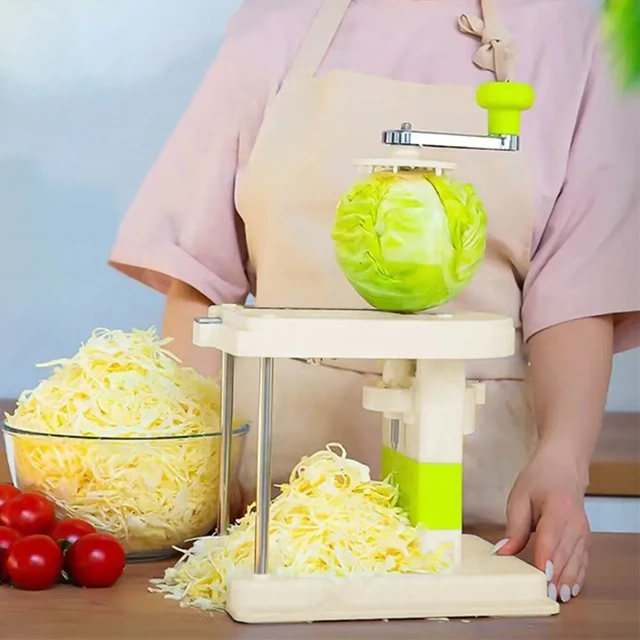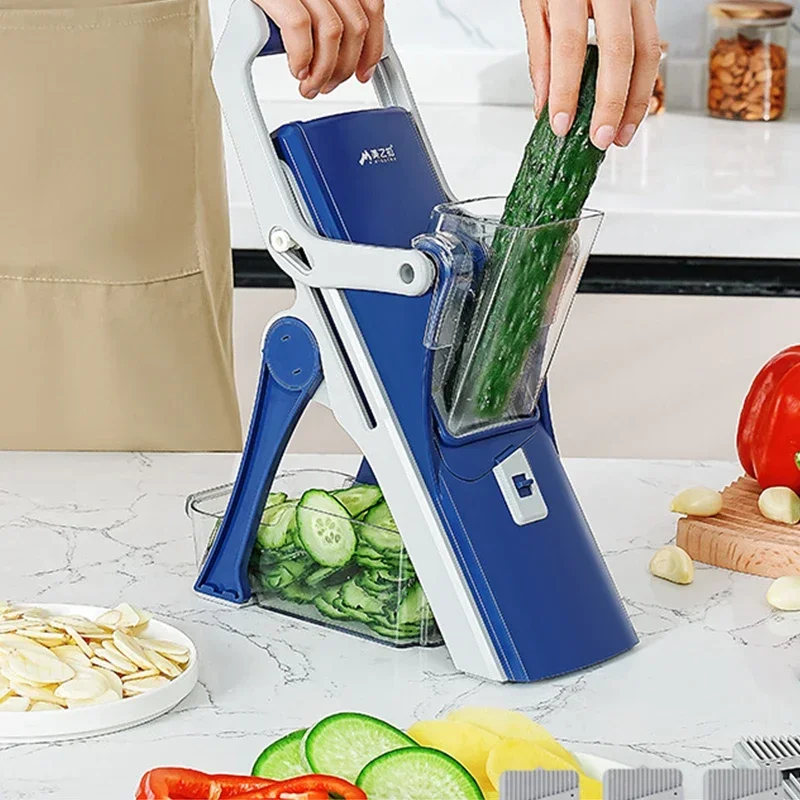 Introduction:
Introduction:
A vegetable slicer is a versatile kitchen tool that simplifies vegetable preparation by providing efficient and precise slicing capabilities. With various performance features and options available, vegetable slicers have become essential for home cooks and professional chefs alike. In this comprehensive guide, we will explore the performance and features of vegetable slicers, the materials used in their construction, and provide essential maintenance and cleaning considerations. By understanding these factors, you can maximize the functionality of your vegetable slicer and keep it in optimal working condition.
 Performance and Features of Vegetable Slicers
Performance and Features of Vegetable Slicers
Adjustable Slicing Thickness:
Many vegetable slicers come with adjustable slicing options, allowing you to choose the desired thickness of the vegetable slices.
This feature enables versatility in preparing different recipes that call for various slicing thicknesses.
Multiple Cutting Styles:
Vegetable slicers often offer different blade attachments or settings to create various cutting styles, such as julienne cuts, waffle cuts, or crinkle cuts.
These options allow for customization and creativity in food presentation.
Safety Features:
Manufacturers incorporate safety features into vegetable slicers to prevent accidental cuts or injuries.
Features such as non-slip bases, finger guards, or pushers ensure safe operation.
Materials Used in Vegetable Slicers
Stainless Steel Blades:
Stainless steel is a common material used for the blades of vegetable slicers.
Stainless steel blades provide durability, corrosion resistance, and precise cutting ability.
Plastic or Metal Body:
The body of the vegetable slicer is often made of plastic or metal.
Plastic provides lightweight and affordability, while metal offers sturdiness and longevity.
Maintenance and Cleaning of Vegetable Slicers
Regular Maintenance:
Keep your vegetable slicer in optimal working condition by regularly inspecting for loose or damaged parts.
Tighten any screws or fixings as needed and replace any worn-out or broken components.
Cleaning Considerations:
Follow the manufacturer’s instructions for specific cleaning guidelines.
Vegetable slicers often have removable parts that can be cleaned separately.
Wash the blades and other removable parts with mild soap and warm water, ensuring thorough cleaning to remove any food debris.
Drying and Storage:
After washing, thoroughly dry all parts of the vegetable slicer before storage.
Ensure blades are completely dry to prevent rusting.
Store the slicer in a clean and dry place to avoid moisture buildup.
 Some common locations where people often place their vegetable slicers:
Some common locations where people often place their vegetable slicers:
The placement of a vegetable slicer depends on personal preference, kitchen layout, and available space. However, here are some common locations where people often place their vegetable slicers:
Kitchen Countertop:
A popular choice is to keep the vegetable slicer on the kitchen countertop. This ensures easy access and convenience while preparing meals. Place it near the food preparation area to minimize movement and enhance efficiency.
Cabinet or Drawer:
If you have limited countertop space or prefer to keep the kitchen tidy, storing the vegetable slicer in a cabinet or drawer can be a good option. Make sure the cabinet or drawer is easily accessible and suitable for the size of the slicer.
Pantry or Shelving:
If you have a pantry or open shelving in your kitchen, consider placing the vegetable slicer on one of the shelves. This keeps it within reach while also minimizing clutter on the countertop.
Kitchen Island:
If you have a kitchen island with sufficient workspace, placing the vegetable slicer on the island can create a convenient and dedicated slicing area. This allows for easy access and keeps the slicer separate from other food preparation activities.
Remember to choose a location that is easily accessible, secure, and suits your workflow in the kitchen. Consider factors such as available space, potential impact on your countertop area, and the frequency of use when deciding where to place your vegetable slicer.
Cleaning Safely and Effectively
Disassembling the Slicer:
Disassemble the slicer by removing blades and other detachable parts carefully.
Follow the manufacturer’s instructions to ensure proper disassembly.
Hand Washing the Blades:
Wash the blades individually with mild soap and warm water, using a sponge or a soft brush to remove any food residue.
Pay attention to small crevices and corners to ensure thorough cleaning.
Cleaning the Body:
Clean the body of the slicer with a damp cloth or sponge, removing any excess food or liquid.
For stubborn stains, use a mild detergent and gentle scrubbing.
Drying and Storing Safely:
Dry all parts thoroughly with a clean towel or air-dry before reassembling the slicer.
Store the slicer in a safe place, away from moisture and heat, to prevent damage or corrosion.
 Popularity for several reasons:
Popularity for several reasons:
Vegetable slicers have gained popularity for several reasons, including:
Time-saving:
Vegetable slicers offer quick and efficient slicing and cutting of vegetables. They streamline the food preparation process, saving time and effort compared to manual slicing with a knife. This is especially beneficial when preparing large quantities of vegetables or when consistently needing uniform slices.
Consistency:
Vegetable slicers provide consistent and uniform slices, ensuring even cooking and presentation. This is particularly useful when making dishes that require precise and consistent slicing, such as salads, stir-fries, or vegetable-based noodles.
Versatility:
Many vegetable slicers come with different blade attachments or adjustable settings, allowing for a variety of cutting styles and techniques. Spiralizers, for example, can create spiral-shaped cuts or “noodles” from various vegetables, expanding culinary possibilities and adding creativity to meals.
Ease of Use:
Vegetable slicers are designed to be user-friendly, making it easy for both experienced chefs and novice cooks to slice vegetables effectively. They often come with intuitive controls, built-in safety features, and non-slip bases to enhance stability during use.
Improved Safety:
Vegetable slicers reduce the risk of accidents by providing a safer alternative to using traditional kitchen knives. Many slicers come with protective handguards or pushers that keep hands away from the blades during slicing, minimizing the chances of cuts or injuries.
Efficiency in Food Waste:
Vegetable slicers can help in utilizing the entire vegetable without unnecessary waste. By slicing vegetables more thinly and evenly, less of the vegetable is discarded, resulting in reduced food waste.
Enhanced Presentation:
The uniform, precise, and visually appealing slices produced by vegetable slicers can elevate the presentation of meals. Whether it’s creating attractive garnishes, uniformly sliced salads, or beautifully plated vegetable-centric dishes, vegetable slicers contribute to creating visually appealing meals.
Overall, the convenience, time-saving benefits, versatility, and improved safety that vegetable slicers offer have contributed to their popularity among home cooks and professional chefs alike.
 Conclusion:
Conclusion:
A vegetable slicer is an invaluable kitchen tool that provides efficiency and precision in vegetable preparation. By understanding the performance and features, materials, and maintenance and cleaning considerations, you can maximize the functionality and lifespan of your vegetable slicer. Whether it’s adjustable slicing thickness, multiple cutting styles, or safety features, vegetable slicers offer versatility and convenience in the kitchen. Remember to prioritize regular maintenance, follow proper cleaning procedures, and ensure safe handling when using and cleaning your vegetable slicer. With proper care and attention, your vegetable slicer will continue to efficiently assist you in preparing delicious and beautifully sliced vegetables for years to come.
